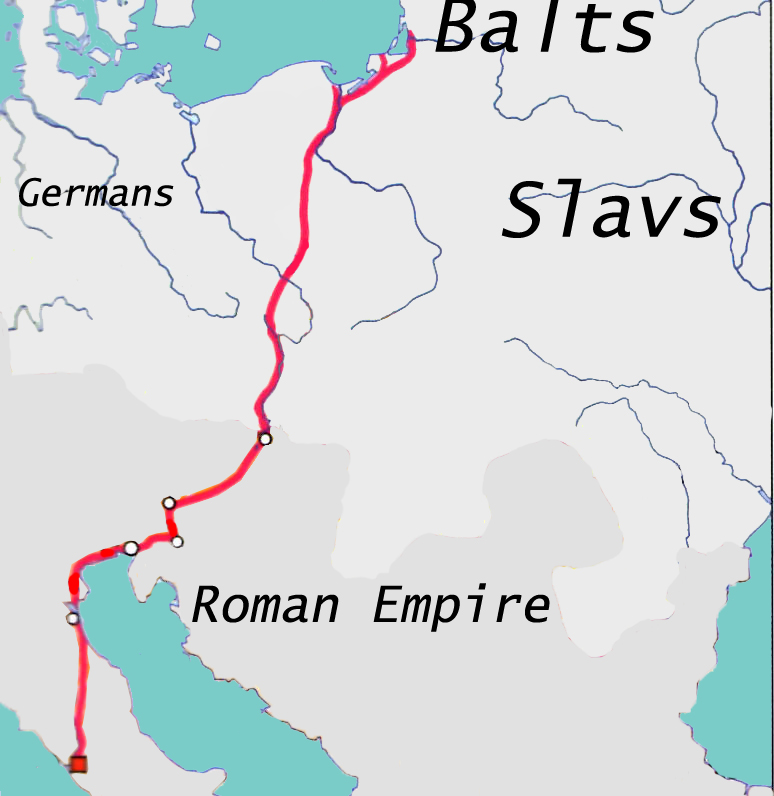The Silk Road, the mega highway that linked the far-flung corners of Eurasia, wasn’t the only grand trade route of the ancient world. In Europe, another historical trade network spanned from the North Sea to the Mediterranean Sea, quenching the wild demand for “the gold of the north” – amber.
It’s impossible to say when the Amber Road emerged. People have been collecting amber from the shores of the Baltic Sea for over 13,000 years, while evidence of long-distance amber trading appears sometime around 3,000 BCE. Regular, more organized amber trading appears to have taken root around 3,500 years ago.
Much like the Silk Road, it wasn’t a single highway, but a complex of numerous interweaving trade routes. It consisted of a loosely organized network of roads and river routes from Northern Europe and the Baltic Sea region, down through present-day Germany, Poland, Austria, Hungary, and Slovenia towards the Mediterranean, including modern-day Italy, Greece, Syria, and Egypt.
Chemical analysis of amber ornaments found in Southern Europe has revealed that much of it originated in Northern Europe or the Baltic Sea area. Even the tomb of ancient Egypt’s most famous boy king, Tutankhamun, contains pieces of Baltic amber.
A map of Central Europe showing the rough course of the Amber Road.
There’s even evidence of Baltic amber in Asia, indicating the Amber Road was even more extensive than previously thought. In 1914, two 3,800-year-old amber beads were discovered near the west bank of the Tigris in Iraq. Using advanced imaging techniques, scientists recently revealed that the amber originated in the Baltic region.
Amber wasn’t the only sought-after commodity traded along the route. Other goods from the north – such as animal skins, furs, honey, and wax – were also exported. In return, the “people of the North” would buy Roman glass, brass, gold, and other metals from the Mediterranean region.
Prized for its deep orange coloring and translucency, amber is a fossilized tree resin that oozes out of some species of conifer trees. These trees grew prolifically in southern parts of Scandinavia and the Baltic region over 45 million years ago, likely resulting in the huge amount of amber deposits found here.
This part of northern Europe is home to the largest known deposits of amber in the world. Along the beaches of the Baltic Sea, it still isn’t unusual to find chunks of amber that have washed up. These coastal areas also produce so-called “sea amber”, which has become smoothed by the ocean’s waves and sometimes features tiny barnacles.
The beautiful material was widely featured in jewelry and other ornaments, just as it is today, but it was also used as a healing agent in folk medicine. Others used concoctions containing amber to ward off evil spirits, demonic figures, and “madness”.
The material is baked into the culture of the Baltic Region, earning it the nickname “gold of the north” or “Slavic gold”. Legend has it that Jūratė, a mermaid-like goddess figure in Lithuanian culture, lived under the Baltic Sea in a beautiful amber castle.
Unusually large deposits of amber can also be located in the Mediterranean, most notably in Sicily at the foothills of the mountains Castrogiovanni (now called Enna) and Caltanissetta. It also appears that people were aware of these deposits in ancient times. This has led many to wonder why the Greeks and Egyptians obtained their amber from Northern Europe when they could have simply shipped it over the Mediterranean.
Still today, however, Baltic amber is highly sought-after for its good looks and unique chemical composition.
Source Link: Amber Road: The Other Great Trade Route Of The Ancient World
